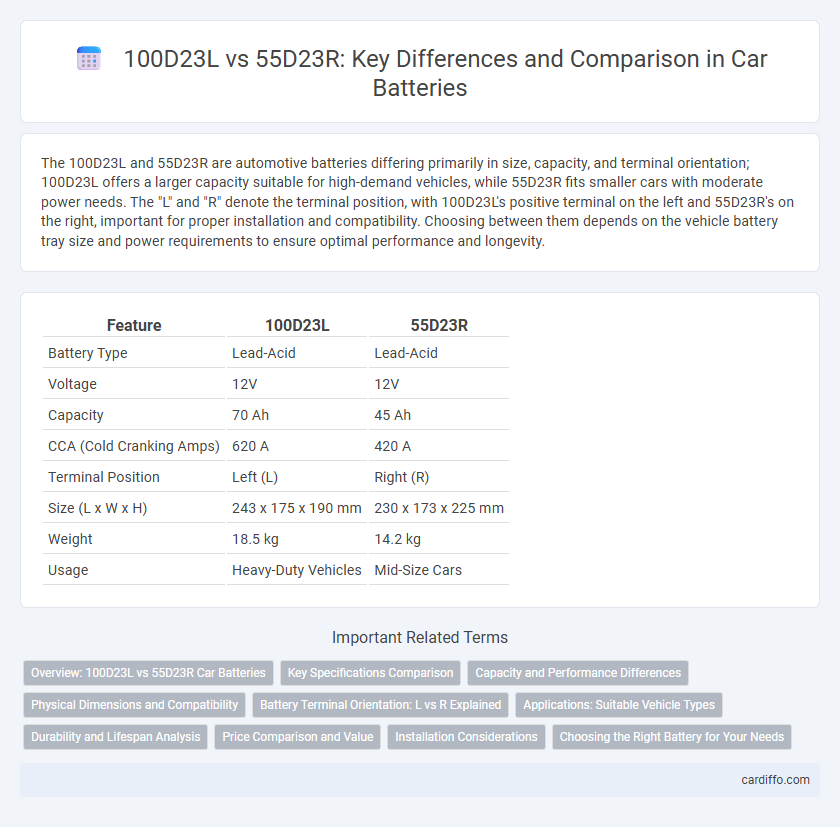The 100D23L and 55D23R are automotive batteries differing primarily in size, capacity, and terminal orientation; 100D23L offers a larger capacity suitable for high-demand vehicles, while 55D23R fits smaller cars with moderate power needs. The "L" and "R" denote the terminal position, with 100D23L's positive terminal on the left and 55D23R's on the right, important for proper installation and compatibility. Choosing between them depends on the vehicle battery tray size and power requirements to ensure optimal performance and longevity.
Table of Comparison
| Feature | 100D23L | 55D23R |
|---|---|---|
| Battery Type | Lead-Acid | Lead-Acid |
| Voltage | 12V | 12V |
| Capacity | 70 Ah | 45 Ah |
| CCA (Cold Cranking Amps) | 620 A | 420 A |
| Terminal Position | Left (L) | Right (R) |
| Size (L x W x H) | 243 x 175 x 190 mm | 230 x 173 x 225 mm |
| Weight | 18.5 kg | 14.2 kg |
| Usage | Heavy-Duty Vehicles | Mid-Size Cars |
Overview: 100D23L vs 55D23R Car Batteries
The 100D23L and 55D23R car batteries differ primarily in size, capacity, and terminal orientation, with the 100D23L offering higher amp-hour ratings and larger physical dimensions suitable for vehicles demanding greater power. Both batteries use lead-acid chemistry, but the 100D23L typically supports larger engines and longer cranking durations, while the 55D23R is common in compact cars needing moderate energy output. Terminal placement is a critical factor, with the 100D23L featuring left-side positive terminals contrasting the right-side placement on the 55D23R, impacting compatibility with specific vehicle models.
Key Specifications Comparison
The 100D23L battery offers a higher capacity of approximately 80Ah compared to the 55D23R's 55Ah, making it more suitable for vehicles with greater power demands. The 100D23L features a left-hand positive terminal, while the 55D23R has a right-hand positive terminal, affecting compatibility with vehicle battery placements. Both batteries provide 12 volts but differ in dimensions, with the 100D23L generally larger to accommodate its higher capacity and power output.
Capacity and Performance Differences
The 100D23L battery offers a higher capacity, typically around 70-75 Ah, compared to the 55D23R's average of 45-50 Ah, resulting in longer runtime and better performance for vehicles with greater power demands. Performance differences include the 100D23L's enhanced cold cranking amps (CCA), which provide superior starting power in colder climates, whereas the 55D23R is more suited for smaller engines with moderate power requirements. Battery size and terminal orientation also affect compatibility, with the 100D23L being larger and featuring left-side positive terminals versus the right-side positive terminals on the 55D23R.
Physical Dimensions and Compatibility
The 100D23L battery features larger physical dimensions compared to the 55D23R, typically measuring around 243mm in length, 175mm in width, and 225mm in height, whereas the 55D23R is usually smaller with dimensions close to 234mm in length, 127mm in width, and 225mm in height. The 100D23L's size and left-side terminal orientation (indicated by the "L") make it compatible with vehicles requiring a larger battery footprint and left terminal configuration. Compatibility depends largely on the battery tray size and terminal position, making the choice between 100D23L and 55D23R crucial for ensuring proper fit and connection in automotive applications.
Battery Terminal Orientation: L vs R Explained
The 100D23L and 55D23R batteries differ primarily in terminal orientation, with the 100D23L featuring left-side positive terminals (L), while the 55D23R has right-side positive terminals (R). This orientation impacts fitment in vehicle battery compartments, ensuring correct cable alignment and preventing installation errors. Understanding the L vs R terminal positions is crucial for selecting the appropriate battery model compatible with specific automotive wiring configurations.
Applications: Suitable Vehicle Types
The 100D23L battery is designed for larger vehicles such as SUVs, trucks, and commercial vans due to its higher capacity and robust starting power. The 55D23R battery fits mid-sized passenger cars and smaller SUVs, offering adequate performance for daily driving and moderate power demands. Vehicle compatibility depends on factors like engine size, power requirements, and terminal orientation, making 100D23L ideal for heavy-duty applications and 55D23R suitable for everyday urban vehicles.
Durability and Lifespan Analysis
The 100D23L battery offers higher durability due to its larger capacity and thicker plates, making it better suited for heavy-duty applications and longer discharge cycles. In contrast, the 55D23R, while smaller and lighter, typically has a shorter lifespan under high load conditions, as its reduced capacity leads to faster degradation. Batteries like the 100D23L generally maintain voltage stability longer, resulting in extended overall lifespan and enhanced performance in demanding environments.
Price Comparison and Value
The 100D23L battery typically costs more than the 55D23R due to its higher capacity and suitability for larger vehicles. While the 55D23R offers a more budget-friendly option with sufficient power for standard applications, the 100D23L delivers better long-term value through enhanced durability and performance. Evaluating price against battery lifespan and energy output is crucial for cost-effective vehicle maintenance.
Installation Considerations
The 100D23L and 55D23R batteries differ primarily in size and terminal orientation, affecting installation compatibility with vehicle battery compartments. The 100D23L is larger and has the positive terminal on the left side, while the 55D23R is smaller with the positive terminal on the right side, requiring proper matching to prevent cable stretching or improper connections. Ensuring accurate measurements and terminal placement is crucial for safe and efficient installation, avoiding potential electrical issues.
Choosing the Right Battery for Your Needs
The 100D23L battery offers higher capacity and longer lifespan suited for heavy-duty vehicles, while the 55D23R battery is ideal for smaller cars requiring moderate power and compact size. Consider vehicle type, power requirements, and terminal orientation--left for 100D23L and right for 55D23R--to ensure compatibility and optimal performance. Evaluating Cold Cranking Amps (CCA) and reserve capacity helps choose a battery that balances reliability and cost-efficiency.
100D23L vs 55D23R Infographic

 cardiffo.com
cardiffo.com